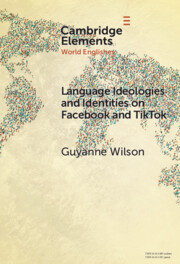Refine search
Actions for selected content:
51 results
2 - Constructing Languages, Constructing Social Life
- from Part I - Theoretical Background and Setting
-
- Book:
- Liquid Languages
- Published online:
- 28 July 2025
- Print publication:
- 14 August 2025, pp 15-37
-
- Chapter
- Export citation
Chapter 3 - Individuals, Networks, Communities, Society: From Variation to Change
-
- Book:
- English Sociolinguistics
- Published online:
- 01 May 2025
- Print publication:
- 15 May 2025, pp 52-83
-
- Chapter
- Export citation
Chapter 2 - From Dialectology to Sociolinguistics: A Short History
-
- Book:
- English Sociolinguistics
- Published online:
- 01 May 2025
- Print publication:
- 15 May 2025, pp 20-51
-
- Chapter
- Export citation
Revisiting the Strategically Deployable Shifter: Manipulating Indeterminacy for Semiotic Power and Profit
-
- Journal:
- Signs and Society / Volume 13 / Issue 1 / March 2025
- Published online by Cambridge University Press:
- 22 April 2025, pp. 9-24
-
- Article
-
- You have access
- Open access
- HTML
- Export citation
Multiplex Tactics and Involvement in Small Storytelling: A Case Study from the Global South
-
- Journal:
- Signs and Society / Volume 13 / Issue 2 / June 2025
- Published online by Cambridge University Press:
- 31 March 2025, pp. 229-251
-
- Article
-
- You have access
- Open access
- HTML
- Export citation
Decoding Bollywood: why Hindi–English code-switching and standard English outrank Indian English
-
- Journal:
- English Language & Linguistics / Volume 28 / Issue 4 / December 2024
- Published online by Cambridge University Press:
- 25 March 2025, pp. 683-708
-
- Article
-
- You have access
- Open access
- HTML
- Export citation
Accent enregisterment through humour in The Catherine Tate Show
-
- Journal:
- English Language & Linguistics / Volume 28 / Issue 4 / December 2024
- Published online by Cambridge University Press:
- 23 January 2025, pp. 730-750
-
- Article
-
- You have access
- Open access
- HTML
- Export citation
The role of dialect in comedy performances: focus on enregisterment and humor
-
- Journal:
- English Language & Linguistics / Volume 28 / Issue 4 / December 2024
- Published online by Cambridge University Press:
- 23 January 2025, pp. 751-773
-
- Article
-
- You have access
- Open access
- HTML
- Export citation
Poetics and Performance: Fanfa Bands and the Semiotic Landscape in Northern Haiti
-
- Journal:
- Signs and Society / Volume 13 / Issue 2 / June 2025
- Published online by Cambridge University Press:
- 10 January 2025, pp. 123-135
-
- Article
-
- You have access
- Open access
- HTML
- Export citation
Chapter 4 - What Is the Role of Context in an Analysis?
-
- Book:
- Introducing Practical Discourse Analysis
- Published online:
- 20 December 2024
- Print publication:
- 09 January 2025, pp 97-126
-
- Chapter
- Export citation

Language Ideologies and Identities on Facebook and TikTok
- A Southern Caribbean Perspective
-
- Published online:
- 17 May 2024
- Print publication:
- 06 June 2024
-
- Element
- Export citation
4 - Indexicality, Deixis, and Space in Gesture
- from Part I - Gestural Types: Forms and Functions
-
-
- Book:
- The Cambridge Handbook of Gesture Studies
- Published online:
- 01 May 2024
- Print publication:
- 18 April 2024, pp 84-111
-
- Chapter
- Export citation
24 - Variation in Gesture: A Sociocultural Linguistic Perspective
- from Part V - Gestures in Relation to Interaction
-
-
- Book:
- The Cambridge Handbook of Gesture Studies
- Published online:
- 01 May 2024
- Print publication:
- 18 April 2024, pp 616-640
-
- Chapter
- Export citation
Rhythm in the Kingdom: a variationist analysis of speech rhythm in Tongan English
-
- Journal:
- English Language & Linguistics / Volume 28 / Issue 2 / June 2024
- Published online by Cambridge University Press:
- 12 March 2024, pp. 203-225
-
- Article
- Export citation
3 - Context in Discourse Analysis
- from Part I - Language in Context: A Sociohistorical Perspective
-
-
- Book:
- The Cambridge Handbook of Language in Context
- Published online:
- 30 November 2023
- Print publication:
- 14 December 2023, pp 71-92
-
- Chapter
- Export citation
3 - How Do We Study the Social Meaning of Grammatical Variation?
-
- Book:
- Socio-syntax
- Published online:
- 19 October 2023
- Print publication:
- 02 November 2023, pp 46-74
-
- Chapter
- Export citation
5 - How Do We Use Grammar to Design Our Talk?
-
- Book:
- Socio-syntax
- Published online:
- 19 October 2023
- Print publication:
- 02 November 2023, pp 111-137
-
- Chapter
- Export citation
4 - How Free Are We to Vary the Grammar We Use?
-
- Book:
- Socio-syntax
- Published online:
- 19 October 2023
- Print publication:
- 02 November 2023, pp 75-110
-
- Chapter
- Export citation
‘Well, taakin about he da bring inta me yead wat I promised var ta tell ee about’: representations of south-western speech in nineteenth-century dialect writing
-
- Journal:
- English Language & Linguistics / Volume 27 / Issue 3 / September 2023
- Published online by Cambridge University Press:
- 16 August 2023, pp. 561-590
-
- Article
- Export citation
Yorkshire folk versus Yorkshire boors: evidence for sociological fractionation in nineteenth-century Yorkshire dialect writing
-
- Journal:
- English Language & Linguistics / Volume 27 / Issue 3 / September 2023
- Published online by Cambridge University Press:
- 04 August 2023, pp. 469-489
-
- Article
-
- You have access
- Open access
- HTML
- Export citation
